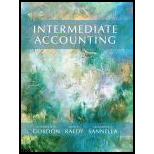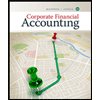
Intermediate Accounting
1st Edition
ISBN: 9780132162302
Author: Elizabeth A. Gordon, Jana S. Raedy, Alexander J. Sannella
Publisher: PEARSON
expand_more
expand_more
format_list_bulleted
Concept explainers
Textbook Question
Chapter 2, Problem 2.16BE
Element Definitions, U.S. GAAP, IFRS. Identify whether the following elements are elements under U.S. GAAP IFRS, or both, and point-in-time or period-in-time elements.
| Element | U.S. GAAP, IFRS, or Both | Point in Time or Period of Time |
| Investments by owners | _________________ | _________________ |
| Income | _________________ | _________________ |
| Losses | _________________ | _________________ |
| Liabilities | _________________ | _________________ |
| Equity | _________________ | _________________ |
| Comprehensive income | _________________ | _________________ |
| Assets | _________________ | _________________ |
| Gains | _________________ | _________________ |
| Capital maintenance adjustment | _________________ | _________________ |
| Expenses | _________________ | _________________ |
| Distributions to owners | _________________ | _________________ |
| Revenues | _________________ | _________________ |
| Performance | _________________ | _________________ |
Expert Solution & Answer
Want to see the full answer?
Check out a sample textbook solution
Students have asked these similar questions
I need help solving this financial accounting question with the proper methodology.
Please show me the correct approach to solving this financial accounting question with proper techniques.
Can you help me solve this financial accounting problem using the correct accounting process?
Chapter 2 Solutions
Intermediate Accounting
Ch. 2 - Prob. 2.1QCh. 2 - Prob. 2.2QCh. 2 - Why is a conceptual framework of accounting...Ch. 2 - Prob. 2.4QCh. 2 - Prob. 2.5QCh. 2 - Prob. 2.6QCh. 2 - Prob. 2.7QCh. 2 - When is financial information considered...Ch. 2 - Prob. 2.9QCh. 2 - Prob. 2.10Q
Ch. 2 - What is the recognition principle and when is an...Ch. 2 - What is the revenue recognition principle and when...Ch. 2 - Prob. 2.14QCh. 2 - When are expenses recognized under IFRS?Ch. 2 - How are transactions recorded under accrual...Ch. 2 - Prob. 2.17QCh. 2 - Prob. 2.1BECh. 2 - Objective of Financial Reporting. Explain the...Ch. 2 - Prob. 2.3BECh. 2 - Fundamental and Enhancing Characteristics....Ch. 2 - Prob. 2.5BECh. 2 - Prob. 2.6BECh. 2 - Prob. 2.7BECh. 2 - Fundamental and Enhancing Characteristics....Ch. 2 - Faithful Representation. Match the component of a...Ch. 2 - Prob. 2.10BECh. 2 - Prob. 2.11BECh. 2 - Capital Maintenance Adjustments, IFRS. Describe...Ch. 2 - Expense Recognition. Discuss the three main...Ch. 2 - Element Definitions. Identify whether the...Ch. 2 - Prob. 2.15BECh. 2 - Element Definitions, U.S. GAAP, IFRS. Identify...Ch. 2 - Prob. 2.17BECh. 2 - Measurement Bases. Match the measurement basis...Ch. 2 - Cash versus Accrual Bases of Accounting. The...Ch. 2 - Assumptions in Financial Reporting. Indicate the...Ch. 2 - Conceptual Framework. Noeleen Auto Mall, Ltd....Ch. 2 - Qualitative Characteristics. Referring to the...Ch. 2 - Prob. 2.3ECh. 2 - Cash versus Accrual Bases of Accounting. Top Notch...
Knowledge Booster
Learn more about
Need a deep-dive on the concept behind this application? Look no further. Learn more about this topic, accounting and related others by exploring similar questions and additional content below.Similar questions
- Can you solve this general accounting question with the appropriate accounting analysis techniques?arrow_forwardCan you solve this general accounting question with accurate accounting calculations?arrow_forwardIn June, one of the processing departments at Amy Manufacturing had beginning work in process inventory of $45,000 and ending work in process inventory of $21,000. During the month, the cost of units transferred out from the department was $632,000. In the department's cost reconciliation report for June, the total cost to be accounted for under the weighted-average method would be____.arrow_forward
- TONY Corporation makes a product whose direct labor standard are 1.3 hours per unit and $14 per hour. In April, the company produced 5,400 units using 7,440 direct labor hours. The actual direct labor cost was $97,550. The labor rate variance for April is _.arrow_forwardPlease explain the solution to this financial accounting problem with accurate principles.arrow_forwardWhat amount will be paid?arrow_forward
arrow_back_ios
SEE MORE QUESTIONS
arrow_forward_ios
Recommended textbooks for you
 Financial And Managerial AccountingAccountingISBN:9781337902663Author:WARREN, Carl S.Publisher:Cengage Learning,
Financial And Managerial AccountingAccountingISBN:9781337902663Author:WARREN, Carl S.Publisher:Cengage Learning, Financial AccountingAccountingISBN:9781337272124Author:Carl Warren, James M. Reeve, Jonathan DuchacPublisher:Cengage Learning
Financial AccountingAccountingISBN:9781337272124Author:Carl Warren, James M. Reeve, Jonathan DuchacPublisher:Cengage Learning Corporate Financial AccountingAccountingISBN:9781305653535Author:Carl Warren, James M. Reeve, Jonathan DuchacPublisher:Cengage Learning
Corporate Financial AccountingAccountingISBN:9781305653535Author:Carl Warren, James M. Reeve, Jonathan DuchacPublisher:Cengage Learning Corporate Financial AccountingAccountingISBN:9781337398169Author:Carl Warren, Jeff JonesPublisher:Cengage Learning
Corporate Financial AccountingAccountingISBN:9781337398169Author:Carl Warren, Jeff JonesPublisher:Cengage Learning Financial & Managerial AccountingAccountingISBN:9781337119207Author:Carl Warren, James M. Reeve, Jonathan DuchacPublisher:Cengage Learning
Financial & Managerial AccountingAccountingISBN:9781337119207Author:Carl Warren, James M. Reeve, Jonathan DuchacPublisher:Cengage Learning Intermediate Accounting: Reporting And AnalysisAccountingISBN:9781337788281Author:James M. Wahlen, Jefferson P. Jones, Donald PagachPublisher:Cengage Learning
Intermediate Accounting: Reporting And AnalysisAccountingISBN:9781337788281Author:James M. Wahlen, Jefferson P. Jones, Donald PagachPublisher:Cengage Learning

Financial And Managerial Accounting
Accounting
ISBN:9781337902663
Author:WARREN, Carl S.
Publisher:Cengage Learning,

Financial Accounting
Accounting
ISBN:9781337272124
Author:Carl Warren, James M. Reeve, Jonathan Duchac
Publisher:Cengage Learning

Corporate Financial Accounting
Accounting
ISBN:9781305653535
Author:Carl Warren, James M. Reeve, Jonathan Duchac
Publisher:Cengage Learning

Corporate Financial Accounting
Accounting
ISBN:9781337398169
Author:Carl Warren, Jeff Jones
Publisher:Cengage Learning

Financial & Managerial Accounting
Accounting
ISBN:9781337119207
Author:Carl Warren, James M. Reeve, Jonathan Duchac
Publisher:Cengage Learning

Intermediate Accounting: Reporting And Analysis
Accounting
ISBN:9781337788281
Author:James M. Wahlen, Jefferson P. Jones, Donald Pagach
Publisher:Cengage Learning
The KEY to Understanding Financial Statements; Author: Accounting Stuff;https://www.youtube.com/watch?v=_F6a0ddbjtI;License: Standard Youtube License